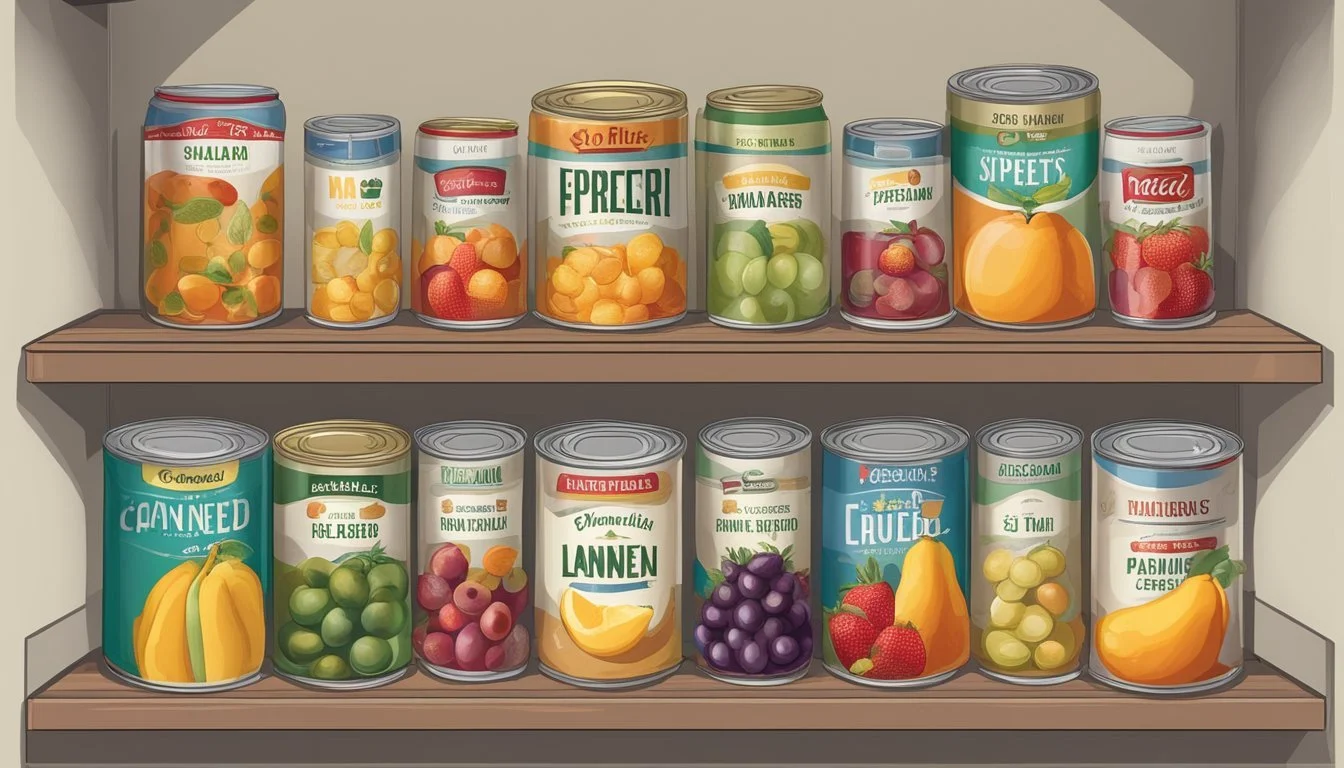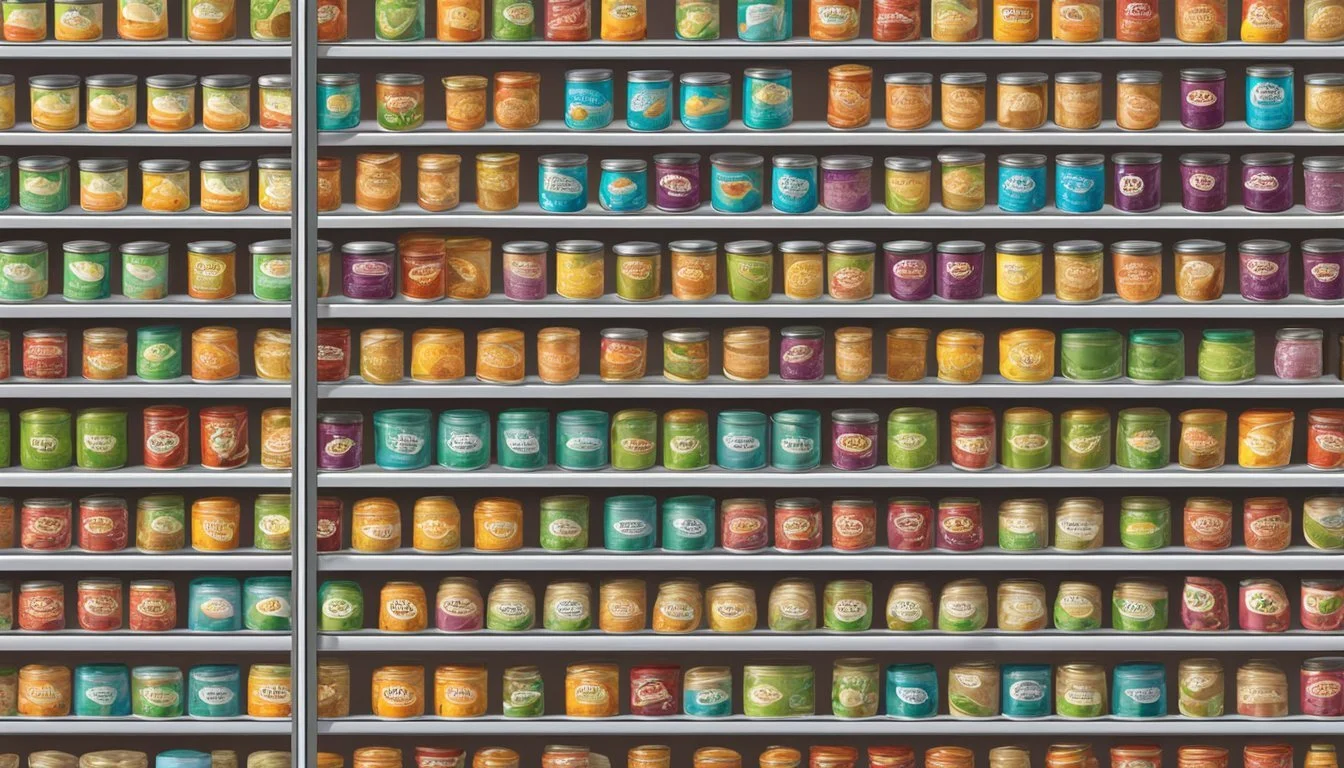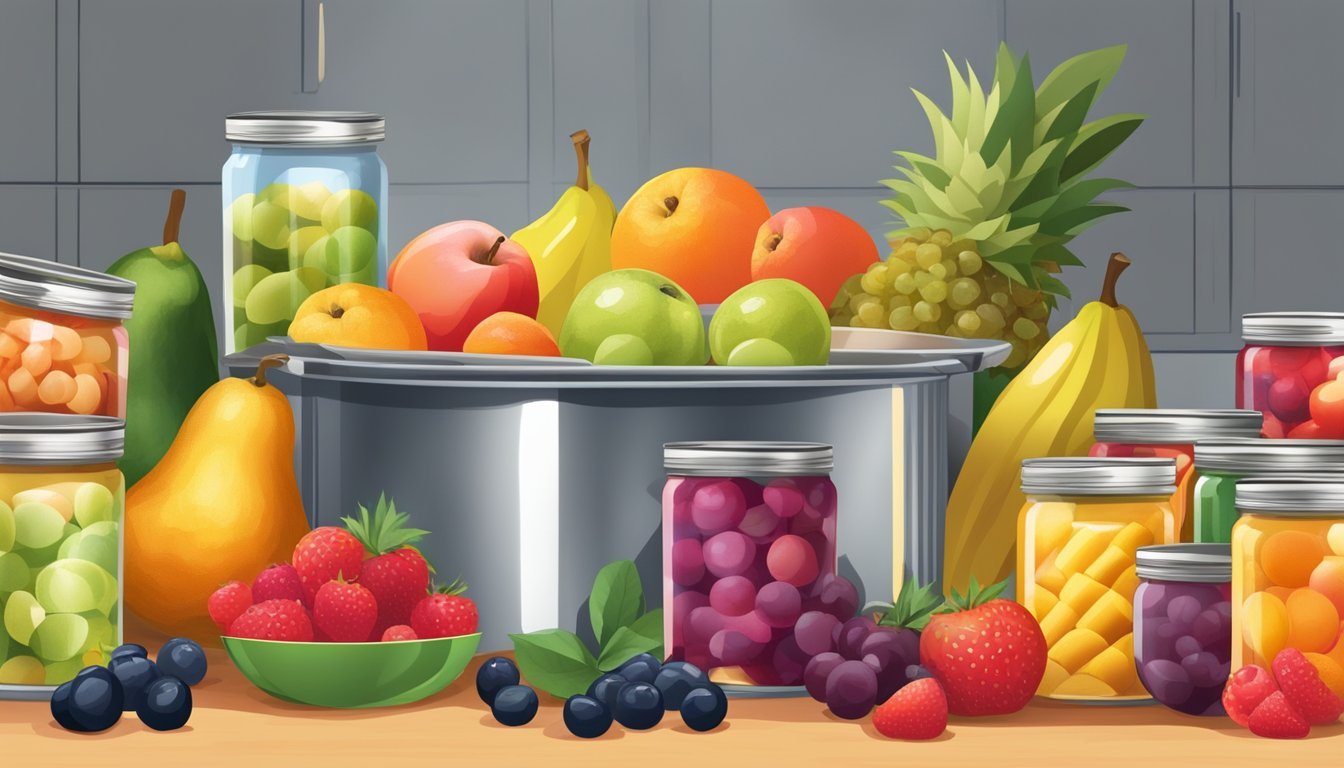Do Canned Fruit Spreads Expire?
Shelf Life and Storage Tips
Canned fruit spreads are a convenient and popular option for enjoying fruit flavors year-round. While they don't have a typical expiration date found on many perishable goods, they do have "best by" dates, which indicate peak quality. Canned fruit spreads can remain safe to consume for several years if unopened and stored properly, but their quality might decline over time.
Once a canned fruit spread is opened, its shelf life significantly shortens. Refrigeration is crucial, and even then, it should be consumed within a week for the best flavor and safety. Proper storage is essential to preserving the quality of these spreads, including keeping them in a cool, dark place away from direct sunlight and heat sources.
Checking for signs of spoilage before consumption is equally important. If a can shows any signs of damage such as dents, leaks, or swelling, it's best to discard it. By understanding the storage and shelf life of canned fruit spreads, consumers can enjoy their favorite fruit flavors safely and deliciously.
Understanding Food Expiration Labels
Food expiration labels can be confusing, yet they play a crucial role in managing the shelf life and safety of items like canned fruit spreads. These labels include terms like 'best-by', 'use-by', and 'sell-by' dates. It is important to know how each label affects both the quality and safety of your food.
Interpreting 'Best-By' and 'Use-By' Dates
Best-By Date: This label indicates when the product will be at its peak quality. It is not an indicator of safety. Canned fruit spreads, for example, may retain their best flavor and texture up to this date. However, they can remain safe to consume after the 'best-by' date if stored properly.
Use-By Date: This is the last date recommended for using the product while at its peak quality. After the 'use-by' date, the item might lose its intended taste and texture but isn't necessarily unsafe. Manufacturers set this date to ensure the best sensory experience for consumers, particularly for products like fruit spreads that rely on flavor and consistency.
Sell-By Date: Primarily aimed at retailers, this date advises how long a store should display the product for sale. It’s not typically directed at consumers but helps in inventory management. For canned fruit spreads, knowing the 'sell-by' date can indicate how long they might be available on store shelves.
The Difference Between Quality and Safety
The terms on expiration labels focus largely on quality rather than safety. While the 'best-by' and 'use-by' dates help ensure you enjoy fruit spreads at their optimal quality, these labels do not typically signify a hard deadline for safety.
Quality: Post 'best-by' or 'use-by' dates, the product might show signs of quality degradation, such as changes in flavor, texture, or color. For fruit spreads, this could mean a less vibrant taste or a thicker or more separated consistency.
Safety: Many canned goods, including fruit spreads, can remain safe well beyond the indicated dates if the can is intact and stored under appropriate conditions. Safety concerns typically arise when there's noticeable damage to the packaging, such as dents, rust, or swelling, which can indicate contamination or spoilage.
By understanding these differences, consumers can better decide when to keep and when to discard their canned fruit spreads, ensuring both enjoyment and healthfulness.
The Shelf Life of Canned Food
Canned food can remain edible and maintain quality for years, depending on several factors like acidity and storage conditions. Low-acid canned goods tend to have a longer shelf life than high-acid ones.
Factors Affecting Canned Food Shelf Life
Several factors influence the shelf life of canned food. Storage conditions play a significant role; cans should be kept in a cool, dry place with temperatures ideally between 50-70°F. Extreme temperatures can degrade the food's quality faster.
Can integrity is crucial as well. Cans must be free from dents, rust, and swelling. Any compromise in the can's integrity can introduce bacteria, leading to spoilage.
Finally, acidity levels impact longevity. High-acid foods such as fruits and tomatoes have shorter shelf lives compared to low-acid foods like meats and vegetables.
Typical Shelf Life for High-Acid and Low-Acid Canned Foods
High-acid canned goods, which include items like tomatoes and citrus fruits, generally maintain their best quality for about 18 months past their printed "use by" or "sell by" dates. These foods can still be safe to consume beyond this period, but their flavor and nutritional value may decrease.
Low-acid canned goods such as meat, poultry, soups (excluding tomato soup), and most vegetables typically have a longer shelf life. These products can often remain in peak condition for up to 2-5 years if stored properly.
Both high-acid and low-acid canned foods should be checked for any signs of spoilage like off-odors, unusual colors, or leaks before consumption.
Canned Fruit Spreads Preservation
Preserving canned fruit spreads involves maintaining optimal storage conditions and ensuring effective vacuum seals. Proper techniques help extend the shelf life and maintain quality.
Optimal Storage Conditions
Canned fruit spreads should be stored in a cool, dry place away from direct sunlight. The ideal storage temperature ranges between 50°F and 70°F (10°C to 21°C).
Extreme temperatures can degrade the quality and safety of the product. If opened, refrigerate the spreads and consume them within 7 days. Use glass, airtight containers for best results.
Avoid storing near heat sources like ovens or stoves. Exposure to fluctuating temperatures reduces the fruit spreads' flavor and texture quality.
Role of Vacuum Seals in Preserving Fruit Spreads
Vacuum seals play a crucial role in preserving canned fruit spreads by removing oxygen and creating a high-vacuum environment.
Vacuum sealing prevents microbial growth and oxidation, which degrade food. Use self-sealing lids and ensure the jars are processed in a boiling-water or pressure canner for the recommended time. This practice helps form a reliable vacuum and ensures the spread's longevity and safety.
Inspect seals regularly for any signs of defects, such as bulging lids or leaks, indicating compromised preservation. Proper sealing helps maintain flavor, texture, and nutritional value.
Identifying Signs of Spoilage
Properly identifying signs of spoilage in canned fruit spreads is crucial for ensuring food safety. Key indicators include visual changes in the cans and noticeable alterations in the opened product's appearance and smell.
Visual Inspection of Cans
Before opening a can, it's essential to examine it for visible signs of spoilage. Bulging, leaking, and swelling are major red flags. Bulging cans indicate a buildup of gas inside, often due to bacterial activity. Leaking suggests the seal is compromised, leading to potential contamination.
Rust spots on the can's exterior can weaken the integrity of the container, making it susceptible to bacteria. Additionally, dented cans should be examined carefully, as dents, especially along seams, can break the seal and allow microorganisms to enter and proliferate.
How to Detect Spoilage in Opened Spreads
Once opened, fruit spreads should be scrutinized for signs of spoilage. Bubbles in the spread can be a sign of fermentation, caused by bacterial growth. If the spread gives off an unusual odor or has a sour smell, it has likely spoiled.
Changes in color can also be a key indicator. Fresh fruit spreads should maintain their vibrant hue; a darker or browner shade might suggest spoilage. Additionally, any unusual textures, such as a slimy surface or separation of liquids, indicate that the spread should not be consumed.
Regularly checking for these signs helps prevent the consumption of spoiled products, ensuring a safe and enjoyable experience.
Health Risks of Expired Canned Foods
Expired canned foods pose several health risks, primarily due to the potential growth of harmful bacteria and toxins. Proper handling and storage of canned foods can mitigate these risks, but certain dangers remain if food is consumed past its safe period.
Understanding Botulism and Other Foodborne Illnesses
Botulism is a severe foodborne illness caused by the bacterium Clostridium botulinum. This bacterium can thrive in low-oxygen environments, such as those found in improperly stored or expired canned foods. The neurotoxin produced by Clostridium botulinum can lead to paralysis and is potentially fatal if not treated promptly.
Symptoms of botulism include:
Difficulty swallowing
Muscle weakness
Blurred vision
These symptoms can occur within 18-36 hours of ingestion.
Other foodborne illnesses, such as food poisoning caused by Salmonella, E. coli, and Listeria, also pose significant risks. These bacteria may thrive in canned foods that have been compromised, leading to nausea, vomiting, diarrhea, and abdominal pain.
Preventing Illnesses Through Safe Consumption
To minimize health risks, it is crucial to adhere to expiration dates and inspect canned foods for signs of spoilage. Look for obvious signs such as:
Swollen cans
Rust or corrosion
Unpleasant odors upon opening
Proper storage, including keeping canned foods in cool, dry places, can extend their shelf life. If you suspect that a can is compromised, it is safer to discard it rather than risk potential illness.
Individuals should also be cautious with high-acid canned foods such as tomatoes and fruits, which are more prone to chemical breakdown and must be consumed within recommended periods. Implementing these safety measures can help prevent serious foodborne illnesses and ensure safe consumption.
Maintaining Quality and Taste
Canned fruit spreads, if properly stored and handled, can retain their quality, taste, and nutritional value for extended periods. Key methods to ensure longevity include appropriate storage after opening and creative use of leftovers.
How to Retain Freshness After Opening
After opening, the freshness of canned fruit spreads like pineapple chutney or apple butter can be preserved by refrigeration.
Transfer the spread to an airtight container to prevent exposure to air and moisture, which can degrade both taste and quality.
Refrigerated spreads typically maintain their best taste and nutritional value for up to three weeks. Label the container with the opening date, which helps in monitoring freshness and preventing spoilage.
Always use clean utensils to avoid contamination, ensuring the spread remains free of bacteria and retains its peak quality.
Utilizing Leftovers in Recipes
Leftover canned fruit spreads can bring vibrant flavors to various recipes.
Use pineapple jam to glaze meats or add to sauerkraut for a sweet and tangy twist. Fruit spreads can enhance desserts like yogurts and pastries or be added to smoothies for extra fruitiness.
Creating marinades or dipping sauces from fruit spreads is a clever way to use leftovers while savoring their unique tastes.
By incorporating these versatile spreads into everyday cooking, not only is waste reduced, but meals are enriched with the distinct flavors and nutrients of the canned fruit spreads.
Long-Term Storage Tips
Properly storing canned fruit spreads can prolong their shelf life and ensure they remain safe to consume. Here’s how to optimize storage conditions and manage your stock effectively.
Best Practices for Pantry Storage
Canned fruit spreads should be stored in a cool, dark place such as a pantry. Temperatures between 50°F to 70°F (10°C to 21°C) are ideal. Excessive heat can cause the contents to spoil faster, while extreme cold might affect the texture and taste of the spread.
Ensure that the storage area is dry to prevent rust on the cans.
Use airtight containers if the original packaging is compromised. This helps maintain the quality of the spreads by preventing exposure to air and contaminants.
Label the products with purchase or expiration dates for easy tracking.
Rotating Stock and Using FIFO (First In, First Out)
FIFO (First In, First Out) is a crucial method for managing canned fruit spreads. Place newer items behind older ones in the pantry. This practice ensures the oldest products are used first, reducing waste.
Regularly check the pantry, ideally every six months, to identify items approaching their expiration dates.
Create an inventory list and update it after every use or purchase. This helps in keeping track of what is on hand and what needs to be replenished.
Inspect cans for any signs of damage or bulging as these can indicate spoilage or contamination.
By following these tips, you can ensure that your canned fruit spreads remain safe and delicious for an extended period.
Canning Process and Shelf Stability
The canning process plays a crucial role in maintaining the shelf stability of fruit spreads. It involves specific steps that help ensure that canned products remain safe and of high quality for extended periods.
How Canning Preserves Food
Canning preserves food by removing oxygen, destroying enzymes, and preventing the growth of bacteria, yeasts, and molds. This is achieved through a combination of methods such as adding acids, using appropriate jars like Mason jars, and sealing them properly.
When the jars are processed in a boiling-water canner or a pressure canner, a high vacuum is formed, which helps keep the food fresh. The high acidity in fruit spreads is critical, as it creates an environment that is inhospitable to harmful microorganisms.
The Importance of Commercial Sterility
Commercially sterile products are those that have undergone processes to ensure they are free from any viable microorganisms that could pose a health risk. This status is achieved through rigorous canning techniques and consistent quality checks.
For home-canned fruit spreads, ensuring commercial sterility involves meticulous procedures. The fruit spreads must be heated to boiling, ensuring that all parts of the jar reach temperatures that kill potential contaminants. Proper sealing practices follow, using self-sealing lids to maintain the vacuum.
The guidelines for commercial sterility are essential for both commercial and home canning to ensure long-term shelf stability and safety. When stored properly, unopened cans can last up to a couple of years without spoilage, making the process invaluable for preserving seasonal fruits.
Incorporating Canned Fruit into Your Diet
Canned fruits are versatile and offer numerous nutritional benefits. They can be easily incorporated into meals and snacks, providing essential vitamins and aiding in creative culinary experiments.
Creative Ideas for Using Fruit Spreads
One way to use canned fruit spreads is in breakfast dishes. Spread them on toast, pancakes, or waffles for a flavorful start to the day.
For lunch, try mixing fruit spreads into salad dressings. A simple vinaigrette can be elevated with the addition of apricot or peach spread.
They also make great additions to sandwiches and wraps, adding a sweet contrast to savory ingredients. Using them as a glaze for meats like chicken or pork can give dishes a delightful balance of sweet and savory flavors.
For desserts, incorporate fruit spreads into baking recipes. They can be used as fillings for cakes, pastries, and cookies.
Blending them into smoothies adds sweetness and reduces the need for additional sugar. Stirring them into yogurt or cottage cheese combines texture and a nutrient boost.
Nutritional Benefits of Canned Fruits
Canned fruits retain many nutrients found in fresh produce. Vitamin C, an important antioxidant, remains present in fruits like mandarins and pears.
These fruits often contain dietary fiber, which supports digestive health. The fiber content can help maintain healthy digestion and prevent constipation.
Canned fruits that are packed in water or natural juice have minimal added sugars. This makes them a healthier choice compared to those in syrup.
Canned fruits also provide essential minerals such as potassium and copper, both vital for cardiovascular and immune function.
By incorporating a variety of canned fruits into the diet, one can enjoy these nutritional benefits while adding variety and convenience to meal planning.






